Quality Improvement Proposal: Improving Patient Care and Reducing Stay
VerifiedAdded on 2022/10/01
|7
|1822
|34
Report
AI Summary
This report outlines a comprehensive quality improvement proposal aimed at reducing patient length of stay (ALOS) in hospitals and enhancing the overall quality of patient care. It begins by identifying inefficiencies in the healthcare sector, specifically focusing on the impact of prolonged hospital stays on both patients and the economy. The proposal emphasizes the importance of improving quality-centric services to streamline patient recovery and care plans, highlighting the significance of maintaining a lower ALOS. The report reviews previous research, including interventions such as the use of specialized teams and modifications to operational activities, and their impact on reducing patient stay durations. It presents a rationale for implementing evidence-based practices, detailing the seven steps involved in building an integrated clinical practice, and emphasizes the role of statistical analysis in evaluating the success of the quality improvement initiative. The report also identifies key variables such as ALOS, bed occupancy rate (BOR), and bed turnover ratio (BTR), and explains how these metrics are essential for assessing the effectiveness of the proposed changes. Overall, the proposal advocates for a collaborative, long-term approach to improve patient-oriented care settings.
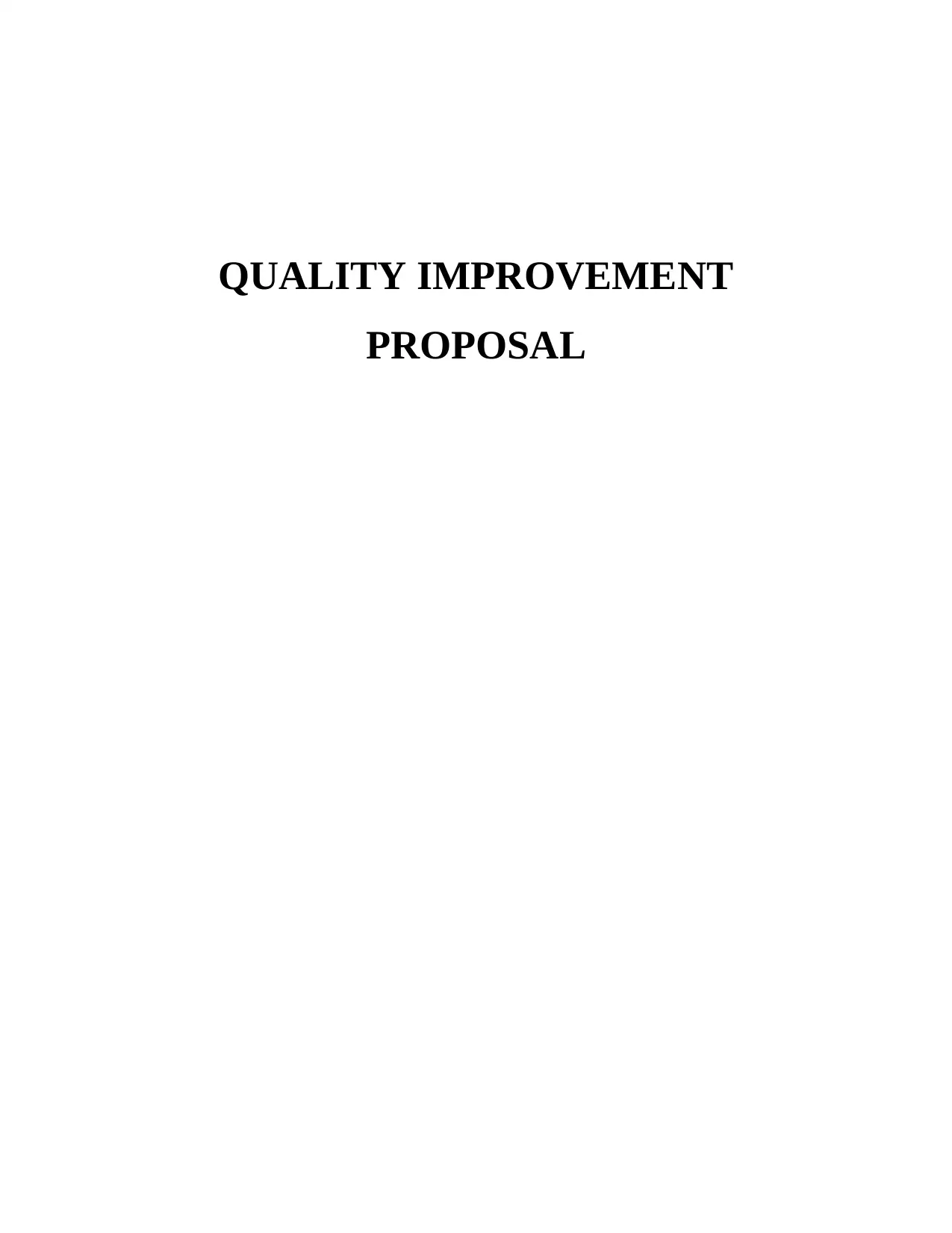
QUALITY IMPROVEMENT
PROPOSAL
PROPOSAL
Paraphrase This Document
Need a fresh take? Get an instant paraphrase of this document with our AI Paraphraser
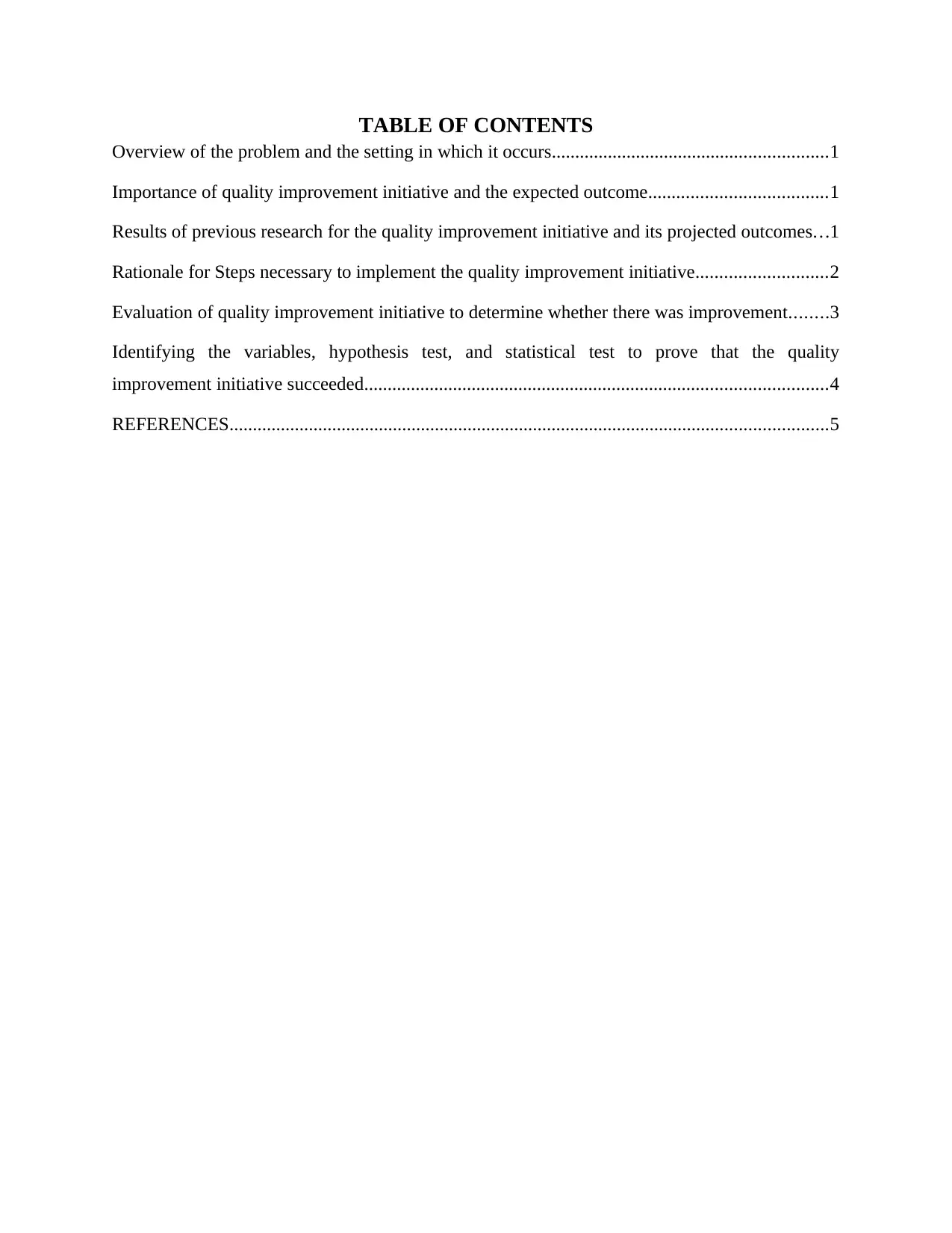
TABLE OF CONTENTS
Overview of the problem and the setting in which it occurs...........................................................1
Importance of quality improvement initiative and the expected outcome......................................1
Results of previous research for the quality improvement initiative and its projected outcomes...1
Rationale for Steps necessary to implement the quality improvement initiative............................2
Evaluation of quality improvement initiative to determine whether there was improvement........3
Identifying the variables, hypothesis test, and statistical test to prove that the quality
improvement initiative succeeded...................................................................................................4
REFERENCES................................................................................................................................5
Overview of the problem and the setting in which it occurs...........................................................1
Importance of quality improvement initiative and the expected outcome......................................1
Results of previous research for the quality improvement initiative and its projected outcomes...1
Rationale for Steps necessary to implement the quality improvement initiative............................2
Evaluation of quality improvement initiative to determine whether there was improvement........3
Identifying the variables, hypothesis test, and statistical test to prove that the quality
improvement initiative succeeded...................................................................................................4
REFERENCES................................................................................................................................5
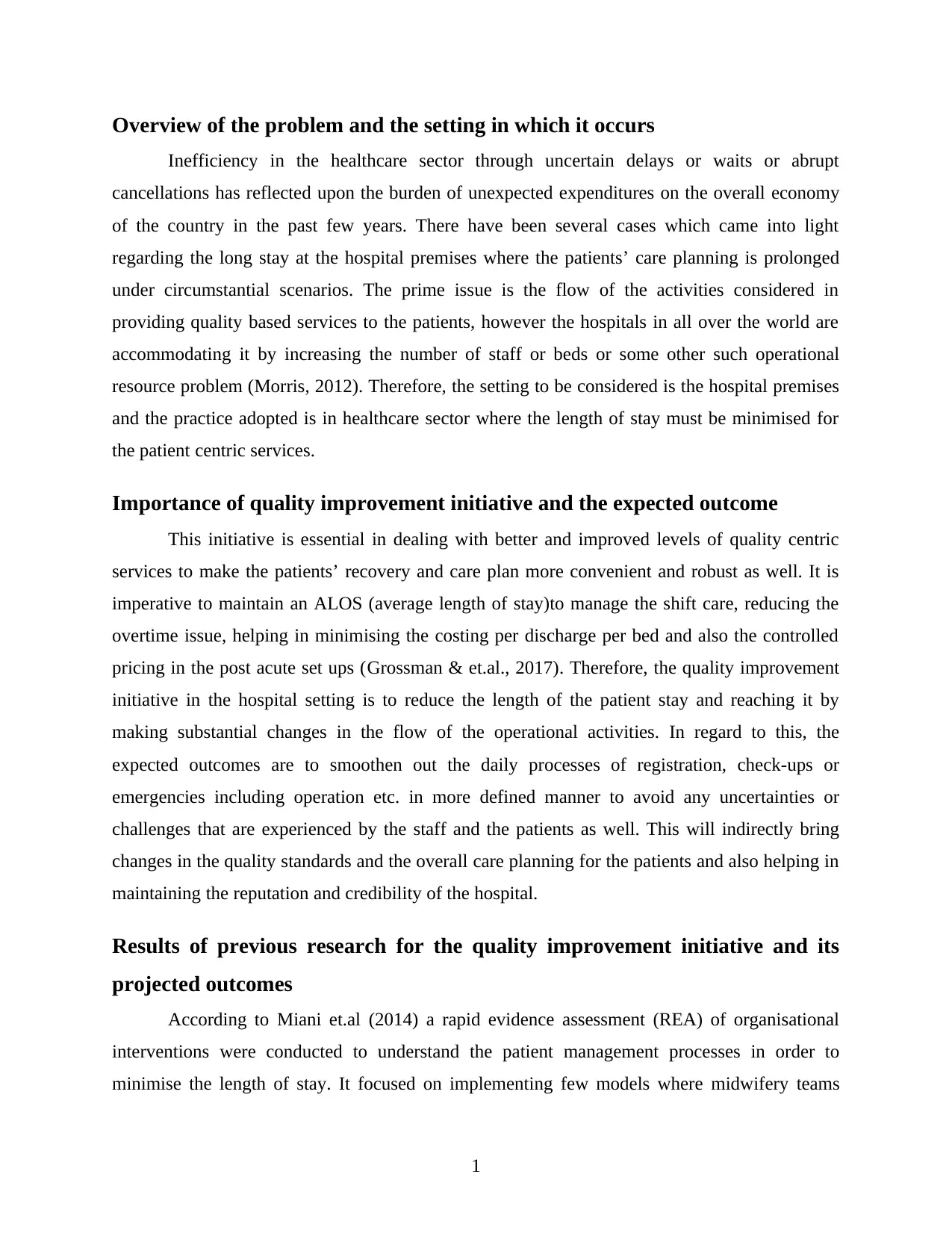
Overview of the problem and the setting in which it occurs
Inefficiency in the healthcare sector through uncertain delays or waits or abrupt
cancellations has reflected upon the burden of unexpected expenditures on the overall economy
of the country in the past few years. There have been several cases which came into light
regarding the long stay at the hospital premises where the patients’ care planning is prolonged
under circumstantial scenarios. The prime issue is the flow of the activities considered in
providing quality based services to the patients, however the hospitals in all over the world are
accommodating it by increasing the number of staff or beds or some other such operational
resource problem (Morris, 2012). Therefore, the setting to be considered is the hospital premises
and the practice adopted is in healthcare sector where the length of stay must be minimised for
the patient centric services.
Importance of quality improvement initiative and the expected outcome
This initiative is essential in dealing with better and improved levels of quality centric
services to make the patients’ recovery and care plan more convenient and robust as well. It is
imperative to maintain an ALOS (average length of stay)to manage the shift care, reducing the
overtime issue, helping in minimising the costing per discharge per bed and also the controlled
pricing in the post acute set ups (Grossman & et.al., 2017). Therefore, the quality improvement
initiative in the hospital setting is to reduce the length of the patient stay and reaching it by
making substantial changes in the flow of the operational activities. In regard to this, the
expected outcomes are to smoothen out the daily processes of registration, check-ups or
emergencies including operation etc. in more defined manner to avoid any uncertainties or
challenges that are experienced by the staff and the patients as well. This will indirectly bring
changes in the quality standards and the overall care planning for the patients and also helping in
maintaining the reputation and credibility of the hospital.
Results of previous research for the quality improvement initiative and its
projected outcomes
According to Miani et.al (2014) a rapid evidence assessment (REA) of organisational
interventions were conducted to understand the patient management processes in order to
minimise the length of stay. It focused on implementing few models where midwifery teams
1
Inefficiency in the healthcare sector through uncertain delays or waits or abrupt
cancellations has reflected upon the burden of unexpected expenditures on the overall economy
of the country in the past few years. There have been several cases which came into light
regarding the long stay at the hospital premises where the patients’ care planning is prolonged
under circumstantial scenarios. The prime issue is the flow of the activities considered in
providing quality based services to the patients, however the hospitals in all over the world are
accommodating it by increasing the number of staff or beds or some other such operational
resource problem (Morris, 2012). Therefore, the setting to be considered is the hospital premises
and the practice adopted is in healthcare sector where the length of stay must be minimised for
the patient centric services.
Importance of quality improvement initiative and the expected outcome
This initiative is essential in dealing with better and improved levels of quality centric
services to make the patients’ recovery and care plan more convenient and robust as well. It is
imperative to maintain an ALOS (average length of stay)to manage the shift care, reducing the
overtime issue, helping in minimising the costing per discharge per bed and also the controlled
pricing in the post acute set ups (Grossman & et.al., 2017). Therefore, the quality improvement
initiative in the hospital setting is to reduce the length of the patient stay and reaching it by
making substantial changes in the flow of the operational activities. In regard to this, the
expected outcomes are to smoothen out the daily processes of registration, check-ups or
emergencies including operation etc. in more defined manner to avoid any uncertainties or
challenges that are experienced by the staff and the patients as well. This will indirectly bring
changes in the quality standards and the overall care planning for the patients and also helping in
maintaining the reputation and credibility of the hospital.
Results of previous research for the quality improvement initiative and its
projected outcomes
According to Miani et.al (2014) a rapid evidence assessment (REA) of organisational
interventions were conducted to understand the patient management processes in order to
minimise the length of stay. It focused on implementing few models where midwifery teams
1
⊘ This is a preview!⊘
Do you want full access?
Subscribe today to unlock all pages.

Trusted by 1+ million students worldwide
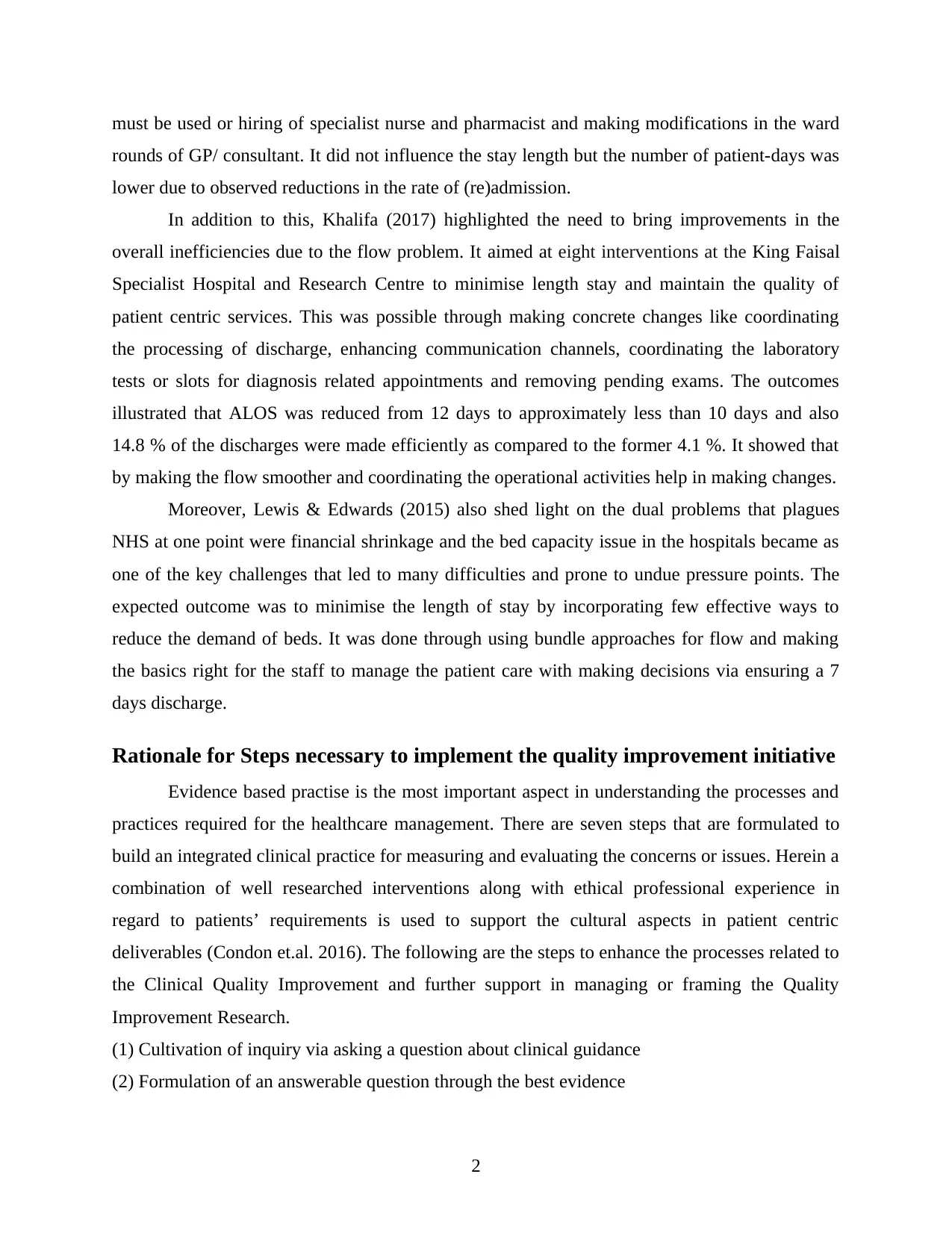
must be used or hiring of specialist nurse and pharmacist and making modifications in the ward
rounds of GP/ consultant. It did not influence the stay length but the number of patient-days was
lower due to observed reductions in the rate of (re)admission.
In addition to this, Khalifa (2017) highlighted the need to bring improvements in the
overall inefficiencies due to the flow problem. It aimed at eight interventions at the King Faisal
Specialist Hospital and Research Centre to minimise length stay and maintain the quality of
patient centric services. This was possible through making concrete changes like coordinating
the processing of discharge, enhancing communication channels, coordinating the laboratory
tests or slots for diagnosis related appointments and removing pending exams. The outcomes
illustrated that ALOS was reduced from 12 days to approximately less than 10 days and also
14.8 % of the discharges were made efficiently as compared to the former 4.1 %. It showed that
by making the flow smoother and coordinating the operational activities help in making changes.
Moreover, Lewis & Edwards (2015) also shed light on the dual problems that plagues
NHS at one point were financial shrinkage and the bed capacity issue in the hospitals became as
one of the key challenges that led to many difficulties and prone to undue pressure points. The
expected outcome was to minimise the length of stay by incorporating few effective ways to
reduce the demand of beds. It was done through using bundle approaches for flow and making
the basics right for the staff to manage the patient care with making decisions via ensuring a 7
days discharge.
Rationale for Steps necessary to implement the quality improvement initiative
Evidence based practise is the most important aspect in understanding the processes and
practices required for the healthcare management. There are seven steps that are formulated to
build an integrated clinical practice for measuring and evaluating the concerns or issues. Herein a
combination of well researched interventions along with ethical professional experience in
regard to patients’ requirements is used to support the cultural aspects in patient centric
deliverables (Condon et.al. 2016). The following are the steps to enhance the processes related to
the Clinical Quality Improvement and further support in managing or framing the Quality
Improvement Research.
(1) Cultivation of inquiry via asking a question about clinical guidance
(2) Formulation of an answerable question through the best evidence
2
rounds of GP/ consultant. It did not influence the stay length but the number of patient-days was
lower due to observed reductions in the rate of (re)admission.
In addition to this, Khalifa (2017) highlighted the need to bring improvements in the
overall inefficiencies due to the flow problem. It aimed at eight interventions at the King Faisal
Specialist Hospital and Research Centre to minimise length stay and maintain the quality of
patient centric services. This was possible through making concrete changes like coordinating
the processing of discharge, enhancing communication channels, coordinating the laboratory
tests or slots for diagnosis related appointments and removing pending exams. The outcomes
illustrated that ALOS was reduced from 12 days to approximately less than 10 days and also
14.8 % of the discharges were made efficiently as compared to the former 4.1 %. It showed that
by making the flow smoother and coordinating the operational activities help in making changes.
Moreover, Lewis & Edwards (2015) also shed light on the dual problems that plagues
NHS at one point were financial shrinkage and the bed capacity issue in the hospitals became as
one of the key challenges that led to many difficulties and prone to undue pressure points. The
expected outcome was to minimise the length of stay by incorporating few effective ways to
reduce the demand of beds. It was done through using bundle approaches for flow and making
the basics right for the staff to manage the patient care with making decisions via ensuring a 7
days discharge.
Rationale for Steps necessary to implement the quality improvement initiative
Evidence based practise is the most important aspect in understanding the processes and
practices required for the healthcare management. There are seven steps that are formulated to
build an integrated clinical practice for measuring and evaluating the concerns or issues. Herein a
combination of well researched interventions along with ethical professional experience in
regard to patients’ requirements is used to support the cultural aspects in patient centric
deliverables (Condon et.al. 2016). The following are the steps to enhance the processes related to
the Clinical Quality Improvement and further support in managing or framing the Quality
Improvement Research.
(1) Cultivation of inquiry via asking a question about clinical guidance
(2) Formulation of an answerable question through the best evidence
2
Paraphrase This Document
Need a fresh take? Get an instant paraphrase of this document with our AI Paraphraser
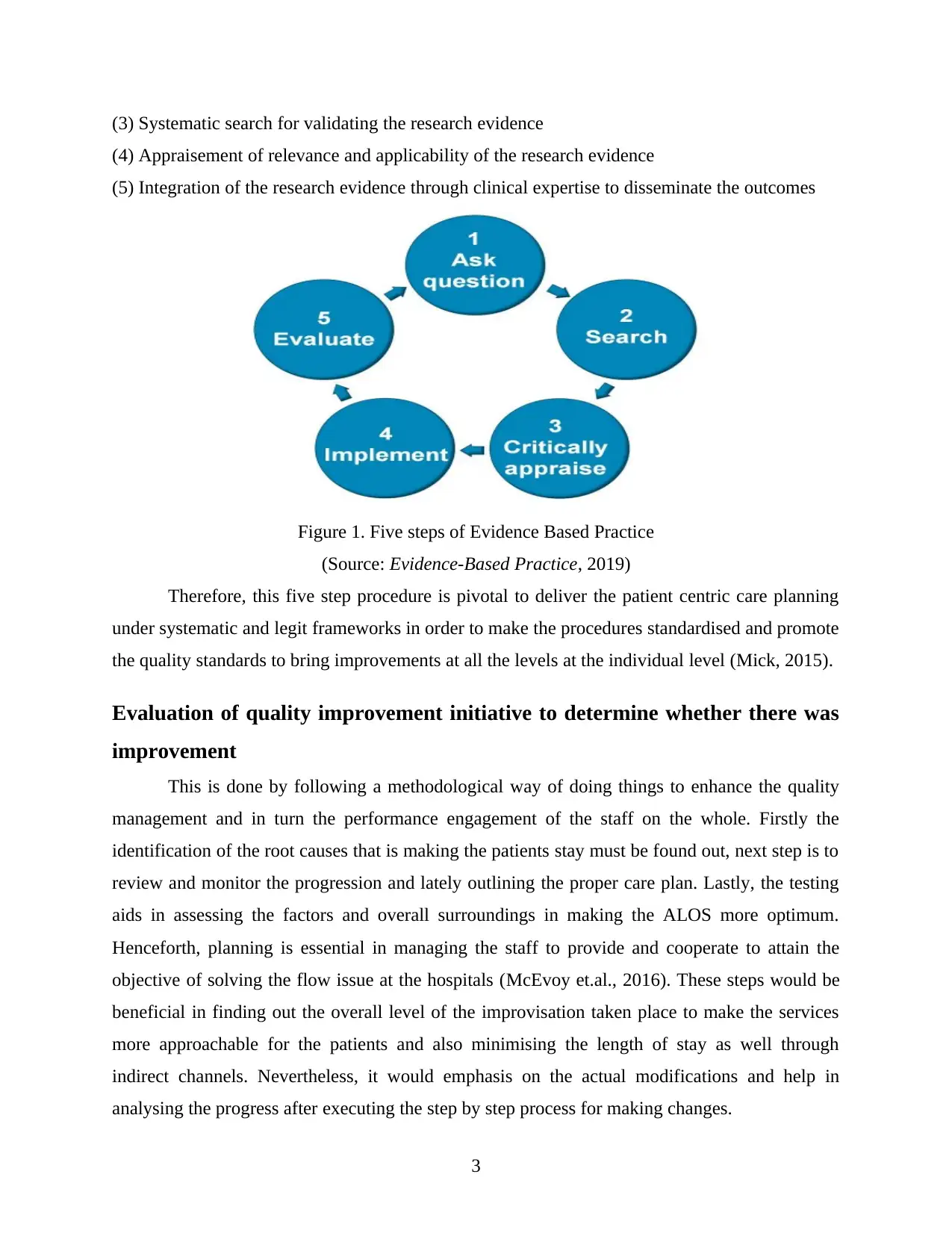
(3) Systematic search for validating the research evidence
(4) Appraisement of relevance and applicability of the research evidence
(5) Integration of the research evidence through clinical expertise to disseminate the outcomes
Figure 1. Five steps of Evidence Based Practice
(Source: Evidence-Based Practice, 2019)
Therefore, this five step procedure is pivotal to deliver the patient centric care planning
under systematic and legit frameworks in order to make the procedures standardised and promote
the quality standards to bring improvements at all the levels at the individual level (Mick, 2015).
Evaluation of quality improvement initiative to determine whether there was
improvement
This is done by following a methodological way of doing things to enhance the quality
management and in turn the performance engagement of the staff on the whole. Firstly the
identification of the root causes that is making the patients stay must be found out, next step is to
review and monitor the progression and lately outlining the proper care plan. Lastly, the testing
aids in assessing the factors and overall surroundings in making the ALOS more optimum.
Henceforth, planning is essential in managing the staff to provide and cooperate to attain the
objective of solving the flow issue at the hospitals (McEvoy et.al., 2016). These steps would be
beneficial in finding out the overall level of the improvisation taken place to make the services
more approachable for the patients and also minimising the length of stay as well through
indirect channels. Nevertheless, it would emphasis on the actual modifications and help in
analysing the progress after executing the step by step process for making changes.
3
(4) Appraisement of relevance and applicability of the research evidence
(5) Integration of the research evidence through clinical expertise to disseminate the outcomes
Figure 1. Five steps of Evidence Based Practice
(Source: Evidence-Based Practice, 2019)
Therefore, this five step procedure is pivotal to deliver the patient centric care planning
under systematic and legit frameworks in order to make the procedures standardised and promote
the quality standards to bring improvements at all the levels at the individual level (Mick, 2015).
Evaluation of quality improvement initiative to determine whether there was
improvement
This is done by following a methodological way of doing things to enhance the quality
management and in turn the performance engagement of the staff on the whole. Firstly the
identification of the root causes that is making the patients stay must be found out, next step is to
review and monitor the progression and lately outlining the proper care plan. Lastly, the testing
aids in assessing the factors and overall surroundings in making the ALOS more optimum.
Henceforth, planning is essential in managing the staff to provide and cooperate to attain the
objective of solving the flow issue at the hospitals (McEvoy et.al., 2016). These steps would be
beneficial in finding out the overall level of the improvisation taken place to make the services
more approachable for the patients and also minimising the length of stay as well through
indirect channels. Nevertheless, it would emphasis on the actual modifications and help in
analysing the progress after executing the step by step process for making changes.
3
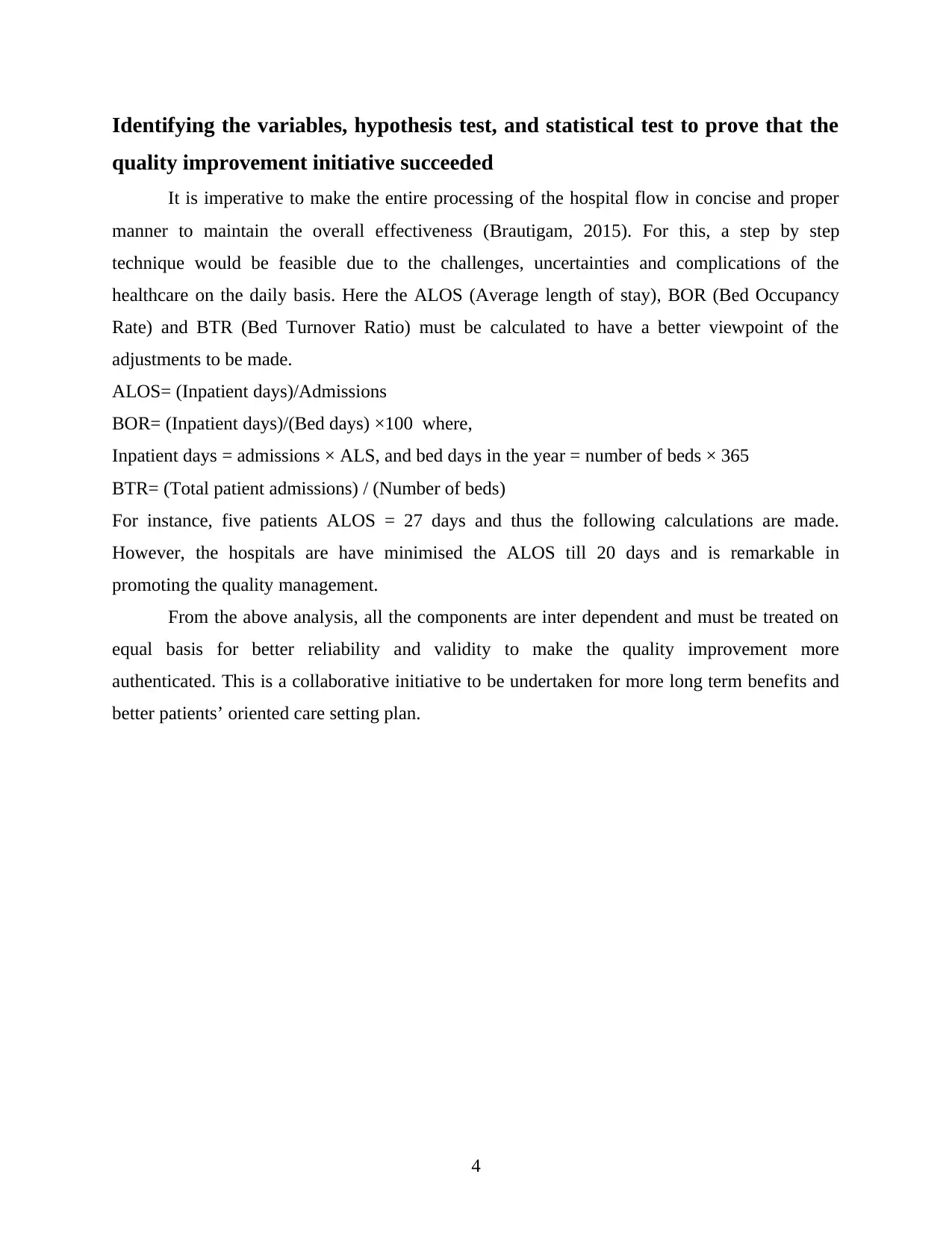
Identifying the variables, hypothesis test, and statistical test to prove that the
quality improvement initiative succeeded
It is imperative to make the entire processing of the hospital flow in concise and proper
manner to maintain the overall effectiveness (Brautigam, 2015). For this, a step by step
technique would be feasible due to the challenges, uncertainties and complications of the
healthcare on the daily basis. Here the ALOS (Average length of stay), BOR (Bed Occupancy
Rate) and BTR (Bed Turnover Ratio) must be calculated to have a better viewpoint of the
adjustments to be made.
ALOS= (Inpatient days)/Admissions
BOR= (Inpatient days)/(Bed days) ×100 where,
Inpatient days = admissions × ALS, and bed days in the year = number of beds × 365
BTR= (Total patient admissions) / (Number of beds)
For instance, five patients ALOS = 27 days and thus the following calculations are made.
However, the hospitals are have minimised the ALOS till 20 days and is remarkable in
promoting the quality management.
From the above analysis, all the components are inter dependent and must be treated on
equal basis for better reliability and validity to make the quality improvement more
authenticated. This is a collaborative initiative to be undertaken for more long term benefits and
better patients’ oriented care setting plan.
4
quality improvement initiative succeeded
It is imperative to make the entire processing of the hospital flow in concise and proper
manner to maintain the overall effectiveness (Brautigam, 2015). For this, a step by step
technique would be feasible due to the challenges, uncertainties and complications of the
healthcare on the daily basis. Here the ALOS (Average length of stay), BOR (Bed Occupancy
Rate) and BTR (Bed Turnover Ratio) must be calculated to have a better viewpoint of the
adjustments to be made.
ALOS= (Inpatient days)/Admissions
BOR= (Inpatient days)/(Bed days) ×100 where,
Inpatient days = admissions × ALS, and bed days in the year = number of beds × 365
BTR= (Total patient admissions) / (Number of beds)
For instance, five patients ALOS = 27 days and thus the following calculations are made.
However, the hospitals are have minimised the ALOS till 20 days and is remarkable in
promoting the quality management.
From the above analysis, all the components are inter dependent and must be treated on
equal basis for better reliability and validity to make the quality improvement more
authenticated. This is a collaborative initiative to be undertaken for more long term benefits and
better patients’ oriented care setting plan.
4
⊘ This is a preview!⊘
Do you want full access?
Subscribe today to unlock all pages.

Trusted by 1+ million students worldwide
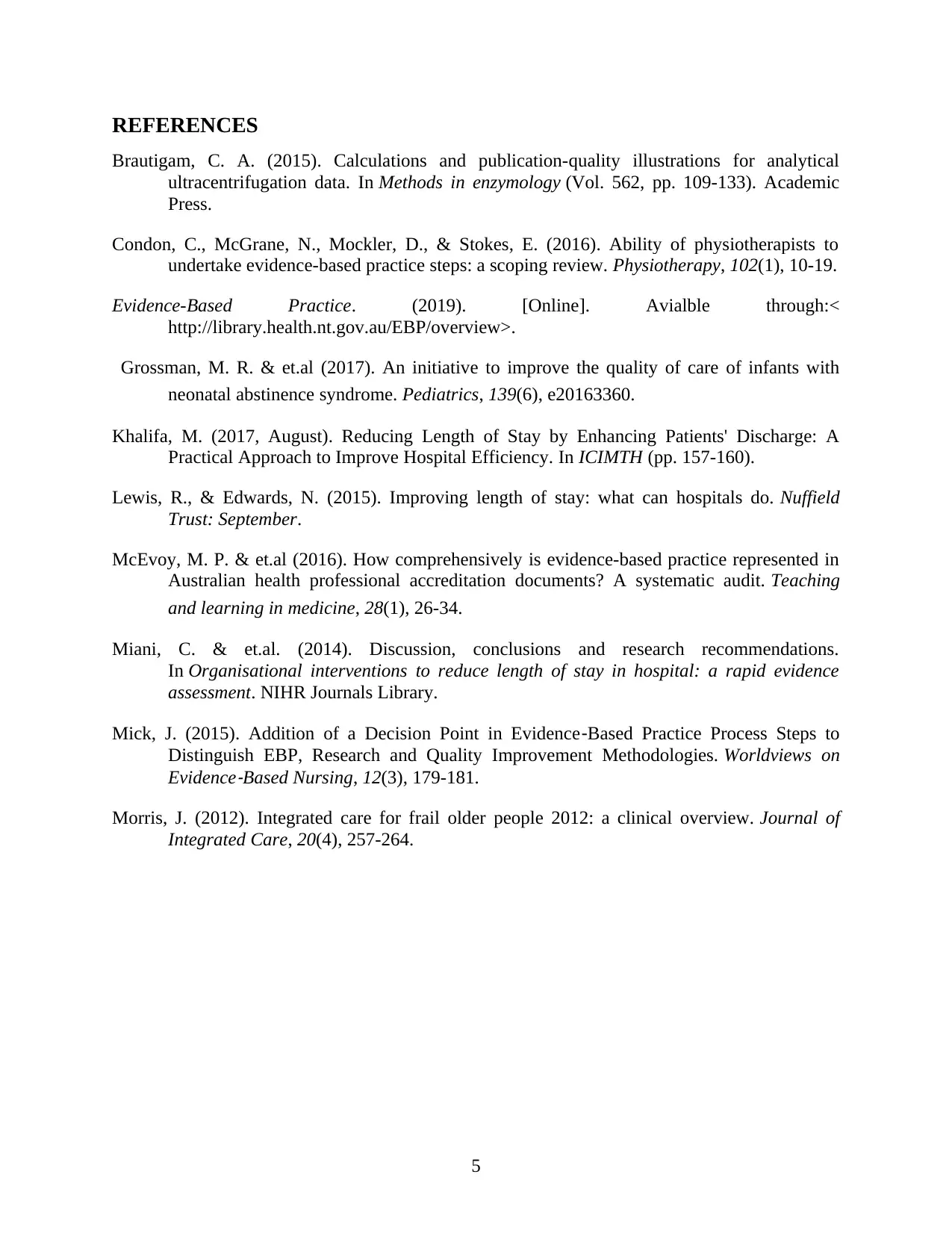
REFERENCES
Brautigam, C. A. (2015). Calculations and publication-quality illustrations for analytical
ultracentrifugation data. In Methods in enzymology (Vol. 562, pp. 109-133). Academic
Press.
Condon, C., McGrane, N., Mockler, D., & Stokes, E. (2016). Ability of physiotherapists to
undertake evidence-based practice steps: a scoping review. Physiotherapy, 102(1), 10-19.
Evidence-Based Practice. (2019). [Online]. Avialble through:<
http://library.health.nt.gov.au/EBP/overview>.
Grossman, M. R. & et.al (2017). An initiative to improve the quality of care of infants with
neonatal abstinence syndrome. Pediatrics, 139(6), e20163360.
Khalifa, M. (2017, August). Reducing Length of Stay by Enhancing Patients' Discharge: A
Practical Approach to Improve Hospital Efficiency. In ICIMTH (pp. 157-160).
Lewis, R., & Edwards, N. (2015). Improving length of stay: what can hospitals do. Nuffield
Trust: September.
McEvoy, M. P. & et.al (2016). How comprehensively is evidence-based practice represented in
Australian health professional accreditation documents? A systematic audit. Teaching
and learning in medicine, 28(1), 26-34.
Miani, C. & et.al. (2014). Discussion, conclusions and research recommendations.
In Organisational interventions to reduce length of stay in hospital: a rapid evidence
assessment. NIHR Journals Library.
Mick, J. (2015). Addition of a Decision Point in Evidence‐Based Practice Process Steps to
Distinguish EBP, Research and Quality Improvement Methodologies. Worldviews on
Evidence
‐Based Nursing, 12(3), 179-181.
Morris, J. (2012). Integrated care for frail older people 2012: a clinical overview. Journal of
Integrated Care, 20(4), 257-264.
5
Brautigam, C. A. (2015). Calculations and publication-quality illustrations for analytical
ultracentrifugation data. In Methods in enzymology (Vol. 562, pp. 109-133). Academic
Press.
Condon, C., McGrane, N., Mockler, D., & Stokes, E. (2016). Ability of physiotherapists to
undertake evidence-based practice steps: a scoping review. Physiotherapy, 102(1), 10-19.
Evidence-Based Practice. (2019). [Online]. Avialble through:<
http://library.health.nt.gov.au/EBP/overview>.
Grossman, M. R. & et.al (2017). An initiative to improve the quality of care of infants with
neonatal abstinence syndrome. Pediatrics, 139(6), e20163360.
Khalifa, M. (2017, August). Reducing Length of Stay by Enhancing Patients' Discharge: A
Practical Approach to Improve Hospital Efficiency. In ICIMTH (pp. 157-160).
Lewis, R., & Edwards, N. (2015). Improving length of stay: what can hospitals do. Nuffield
Trust: September.
McEvoy, M. P. & et.al (2016). How comprehensively is evidence-based practice represented in
Australian health professional accreditation documents? A systematic audit. Teaching
and learning in medicine, 28(1), 26-34.
Miani, C. & et.al. (2014). Discussion, conclusions and research recommendations.
In Organisational interventions to reduce length of stay in hospital: a rapid evidence
assessment. NIHR Journals Library.
Mick, J. (2015). Addition of a Decision Point in Evidence‐Based Practice Process Steps to
Distinguish EBP, Research and Quality Improvement Methodologies. Worldviews on
Evidence
‐Based Nursing, 12(3), 179-181.
Morris, J. (2012). Integrated care for frail older people 2012: a clinical overview. Journal of
Integrated Care, 20(4), 257-264.
5
1 out of 7
Related Documents
Your All-in-One AI-Powered Toolkit for Academic Success.
+13062052269
info@desklib.com
Available 24*7 on WhatsApp / Email
![[object Object]](/_next/static/media/star-bottom.7253800d.svg)
Unlock your academic potential
Copyright © 2020–2025 A2Z Services. All Rights Reserved. Developed and managed by ZUCOL.





